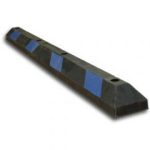
Introduction
What are rubber parking blocks?
Rubber parking blocks are durable and versatile safety devices that are commonly used in parking lots and garages. They are designed to provide a visible barrier and guidance for vehicles, preventing them from crossing into restricted areas or colliding with walls or other vehicles. Made from high-quality rubber, these parking blocks are resistant to extreme weather conditions, UV rays, and chemicals, ensuring long-lasting performance. Additionally, they are easy to install and require minimal maintenance. With their bright yellow color and reflective strips, rubber parking blocks enhance visibility and improve overall safety in parking areas. Whether you are managing a commercial parking lot or a residential garage, rubber parking stops are an essential addition to ensure efficient parking and protect both vehicles and property.
Benefits of using rubber parking blocks
Rubber parking blocks offer numerous benefits that make them an excellent choice for parking lot installations. Firstly, they provide enhanced visibility due to their bright colors, making it easier for drivers to see and navigate parking spaces. Additionally, rubber parking blocks are highly durable and can withstand heavy vehicle traffic without cracking or breaking. This durability ensures long-lasting performance and reduces the need for frequent replacements. Moreover, rubber parking blocks are eco-friendly as they are made from recycled materials, contributing to a sustainable environment. Lastly, these blocks are easy to install and require minimal maintenance, saving time and effort for property owners. Overall, the use of rubber parking blocks offers convenience, safety, and environmental benefits, making them a preferred option for parking lot installations.
Importance of proper installation
Proper installation of rubber parking blocks is of utmost importance to ensure their functionality and longevity. When parking blocks are not installed correctly, they can become loose or unstable, posing a safety hazard for vehicles and pedestrians. Additionally, improper installation can lead to premature wear and tear, reducing the effectiveness of the parking blocks in guiding and protecting vehicles. By following a step-by-step guide for installation, you can ensure that the rubber parking blocks are securely fixed in place, providing a reliable and durable solution for parking management.
Step 1: Preparing the Installation Area
Choosing the right location
Choosing the right location for installing rubber parking blocks is crucial for ensuring their effectiveness and longevity. When selecting a location, it is important to consider factors such as the traffic flow, visibility, and accessibility. Ideally, the parking blocks should be placed in areas where vehicles frequently park or where there is a need to clearly define parking spaces. Additionally, it is essential to ensure that the ground is level and free from any obstructions that may hinder the installation process. By carefully choosing the right location, you can maximize the benefits of rubber parking blocks and enhance the overall parking experience.
Clearing the area
Before installing the rubber parking blocks, it is important to clear the area where they will be placed. Start by removing any debris, rocks, or other obstacles that may be in the way. This will ensure a smooth and level surface for the installation. Additionally, check for any underground utilities or cables that may be present in the area. It is crucial to avoid damaging these utilities during the installation process. Once the area is cleared and checked for any potential hazards, you can proceed with the installation of the rubber parking blocks.
Measuring and marking the placement
When it comes to installing rubber parking blocks, one of the crucial steps is measuring and marking the placement. Before you begin the installation process, it is important to accurately measure the area where the parking blocks will be placed. This will ensure that the blocks are positioned correctly and provide maximum effectiveness. Using a measuring tape, carefully measure the distance between each parking space and mark the spots where the blocks will be installed. Taking the time to measure and mark the placement accurately will result in a smooth and hassle-free installation process.
Step 2: Gathering the Necessary Tools and Materials
Rubber parking blocks
Rubber parking blocks are a practical and cost-effective solution for ensuring proper parking alignment and safety. These durable blocks are designed to withstand heavy vehicles and harsh weather conditions, making them ideal for both indoor and outdoor parking areas. Installing rubber parking blocks is a straightforward process that can be completed in just a few simple steps. This step-by-step guide will walk you through the installation process, providing you with all the information you need to successfully install rubber parking blocks and enhance the functionality of your parking space.
Measuring tape
After gathering all the necessary tools and materials, the first step in installing rubber parking blocks is to measure the area where they will be placed. This is done using a measuring tape to ensure accurate and precise placement. Start by measuring the width of the parking space, making sure to account for any curbs or obstructions. Next, measure the length of the parking space, taking into consideration any slopes or uneven surfaces. These measurements will help determine the number and placement of the rubber parking blocks for optimal functionality and safety.
Chalk or marking paint
Chalk or marking paint is an essential tool when it comes to installing rubber parking blocks. Before the installation process begins, it is important to mark the desired location where the parking blocks will be placed. Chalk or marking paint can be used to create clear and visible lines on the ground, indicating the exact positioning of the parking blocks. This ensures accuracy and precision during the installation process, making it easier to align and secure the blocks properly. Whether you choose chalk or marking paint, both options provide a temporary marking solution that can be easily removed or washed away once the installation is complete. By using chalk or marking paint, you can ensure a hassle-free installation of rubber parking blocks.
Step 3: Installing the Rubber Parking Blocks
Positioning the first block
Positioning the first block is a crucial step in the installation process of rubber parking blocks. To ensure proper alignment and stability, it is important to carefully choose the location for the first block. Start by identifying the desired position and mark it on the ground using chalk or tape. Next, clean the area thoroughly to remove any debris or obstacles that may interfere with the installation. Once the area is prepared, place the first block in the marked position, making sure it is level and flush with the ground. This initial block will serve as the reference point for the rest of the installation, so it is essential to take the time to position it accurately. By following these steps, you can ensure a successful installation of rubber parking blocks.
Aligning the blocks
To align the rubber parking blocks, start by ensuring that the installation area is clean and free of any debris. Place the first block at the desired location and use a level to check if it is perfectly level. Adjust the position of the block if necessary. Once the first block is aligned, place the next block next to it, making sure they are touching each other. Continue this process until all the blocks are aligned and in the desired position. Double-check the alignment of each block before proceeding to the next step of the installation process.
Securing the blocks
Securing the rubber parking blocks is an essential step in the installation process. To ensure the blocks stay in place and provide effective parking guidance, there are a few methods you can use. One option is to use heavy-duty adhesive to firmly attach the blocks to the ground. This adhesive creates a strong bond that can withstand heavy vehicle traffic. Another method is to use anchor bolts to secure the blocks. By drilling holes into the ground and inserting the bolts, you can ensure the blocks are securely fastened. Whichever method you choose, it is important to follow the manufacturer’s instructions and guidelines for proper installation. Taking the time to properly secure the blocks will help prolong their lifespan and ensure they remain in place for years to come.
Step 4: Finishing Touches
Checking the alignment
After checking the alignment of the rubber parking blocks, it is important to ensure that they are properly positioned before installation. This step is crucial in order to maintain a level surface and prevent any potential damage or accidents. To do this, carefully measure the distance between each parking block and make any necessary adjustments. It is also recommended to double-check the alignment by using a level to ensure that the blocks are perfectly straight. Taking the time to properly align the rubber parking blocks will ensure a seamless installation process and a secure parking area for vehicles.
Adding reflective tape
Adding reflective tape is an important step in the installation process of rubber parking blocks. Reflective tape enhances visibility, especially during low light conditions, making it easier for drivers to see the parking blocks. This is particularly crucial in parking lots or areas with heavy traffic. By adding reflective tape to the parking blocks, it helps prevent accidents and promotes safety. Moreover, the reflective tape also adds a professional and polished look to the parking blocks, giving them a more aesthetically pleasing appearance. To add the reflective tape, simply peel off the backing and carefully apply it to the desired areas of the parking block. Ensure that it is securely adhered and free from any air bubbles or wrinkles. Take the time to align the tape properly for a neat and uniform look. Overall, adding reflective tape to rubber parking blocks is a simple yet effective way to improve visibility and enhance safety in parking areas.
Conclusion
The installation process for rubber parking blocks is a simple and straightforward procedure. This article provides a step-by-step guide to help you easily install rubber parking blocks in your desired location. The summary of the installation process includes preparing the area, positioning the blocks, securing them in place, and ensuring proper alignment. By following these instructions, you can quickly and effectively install rubber parking blocks to enhance safety and organization in your parking lot or garage.
Proper installation of rubber parking blocks is of utmost importance for ensuring safety. These blocks are designed to provide a physical barrier that helps prevent vehicles from crossing designated parking areas. When installed correctly, they can effectively guide drivers and protect pedestrians, reducing the risk of accidents and injuries. By following a step-by-step installation guide, you can ensure that the rubber parking blocks are securely placed and aligned, maximizing their effectiveness. Neglecting proper installation procedures can compromise the functionality of these blocks, potentially leading to accidents and property damage. Therefore, it is crucial to prioritize the correct installation of rubber parking blocks to promote safety in parking areas.






